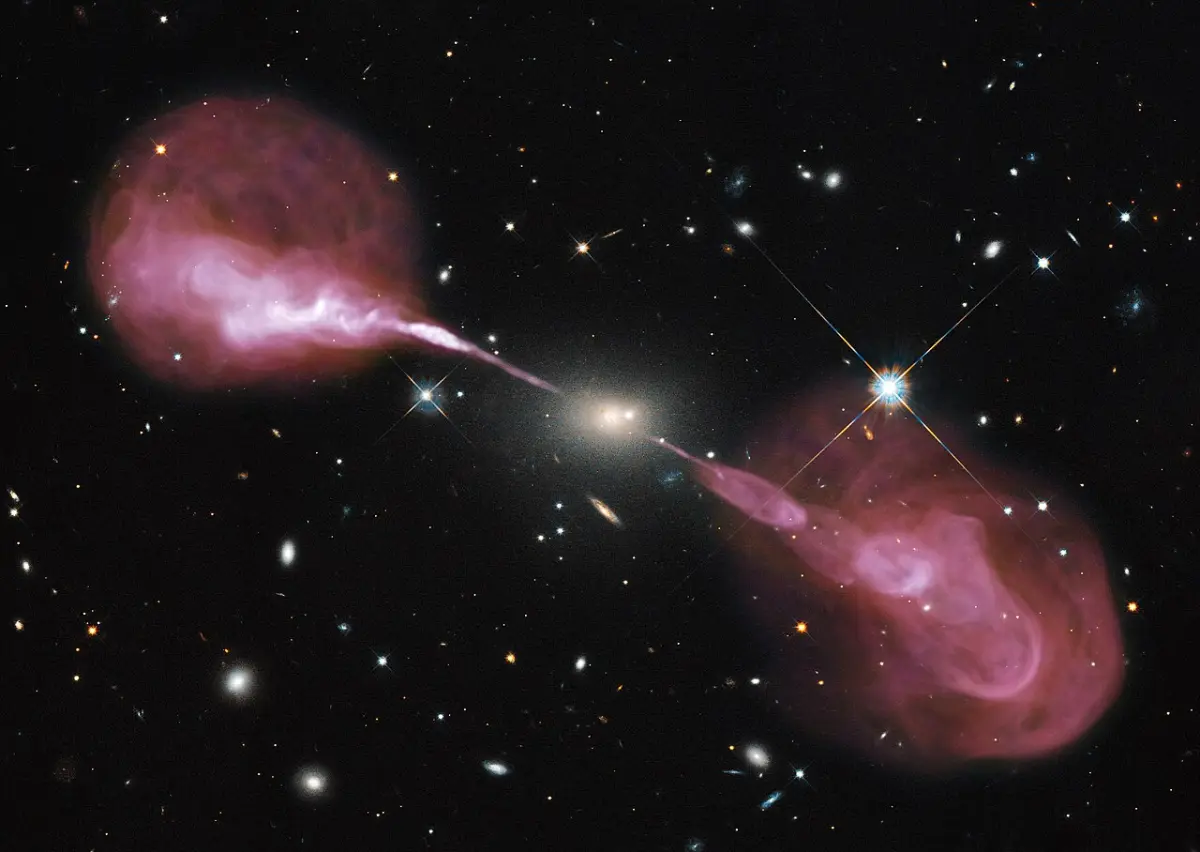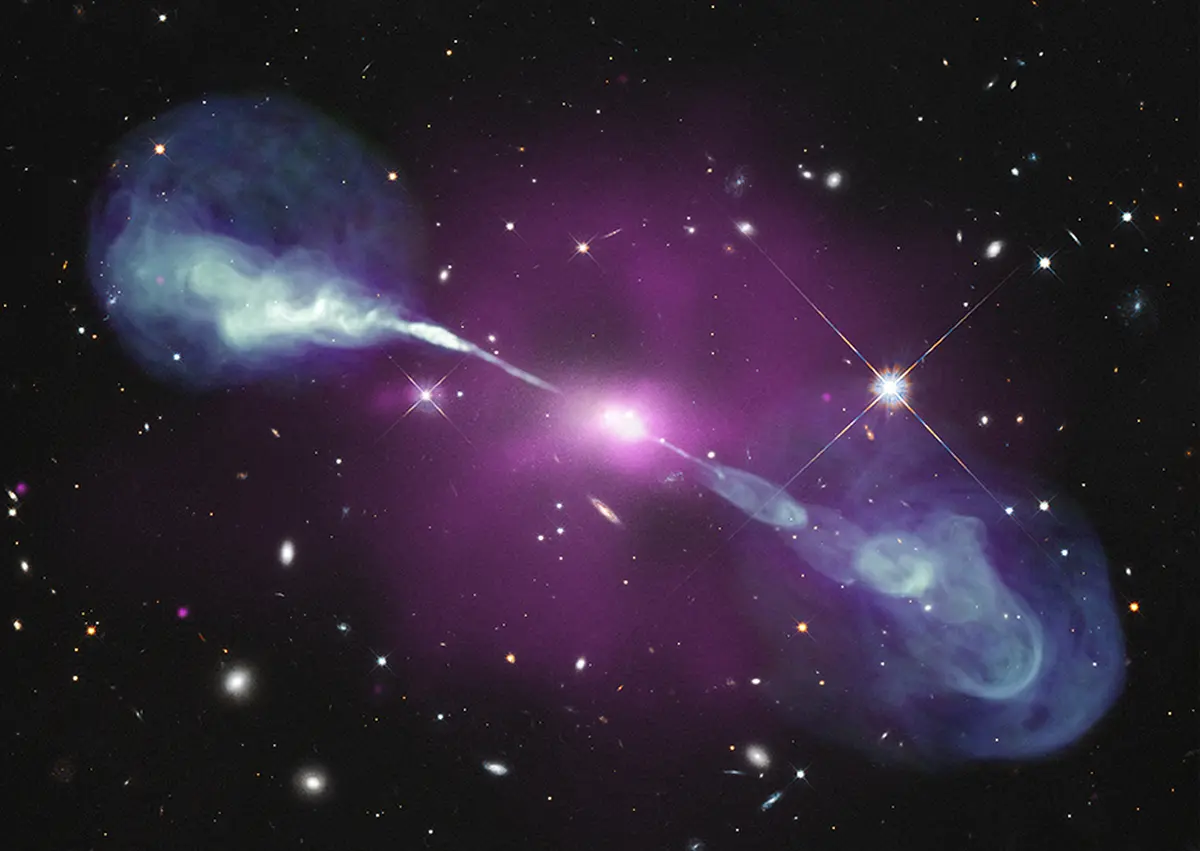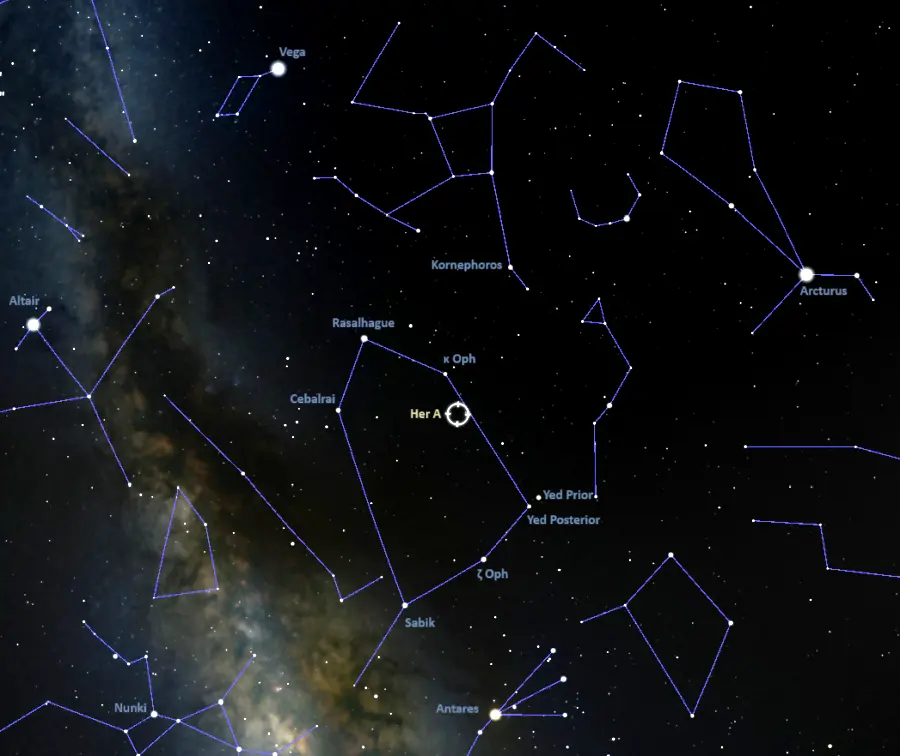Hercules A is a bright radio source located over 2 billion light-years away in the constellation Hercules. The source corresponds to the supergiant elliptical galaxy 3C 348. The active galaxy is over 1,000 times more massive than the Milky Way and contains one of the largest central supermassive black holes known. The black hole has a mass of around 4 billion solar masses.
The yellowish elliptical galaxy 3C 348 appears like a normal elliptical galaxy when imaged in visible light. However, observations in the radio band reveal enormous plasma jets extending for over one million light years. The spectacular jets of plasma that emanate from the galaxy’s core travel at velocities close to the speed of light. The lobes extend over 1.5 million years, making the supergiant elliptical host galaxy appear small in comparison. The jets are invisible in optical images, but glow in radio wavelengths.
Hercules A is a member of the poor galaxy cluster BAX 252.7839+04.9926. It is the cluster’s brightest and most massive member. For this reason, the cluster is often referred to as the Hercules A Cluster or the 3C 348 Cluster.

Spectacular jets powered by the gravitational energy of a supermassive black hole in the core of the elliptical galaxy Hercules A illustrate the combined imaging power of two of astronomy’s cutting-edge tools, the Hubble Space Telescope’s Wide Field Camera 3, and the Karl G. Jansky Very Large Array (VLA) radio telescope in New Mexico. The innocuous-looking galaxy, also known as 3C 348, has long been known as the brightest radio-emitting object in the constellation Hercules. Emitting nearly a billion times more power in radio wavelengths than our Sun, the galaxy is one of the brightest extragalactic radio sources in the entire sky. The VLA radio data reveal enormous, optically invisible jets that, at one-and-a-half million light-years wide, dwarf the visible galaxy from which they emerge. The jets are very-high-energy plasma beams, subatomic particles and magnetic fields shot at nearly the speed of light from the vicinity of the black hole. The outer portions of both jets show unusual ring-like structures suggesting a history of multiple outbursts from the supermassive black hole at the centre of the galaxy. Far from the galaxy, the jets become unstable and break up into the rings and wisps. The entire radio source is surrounded by a very hot, X-ray-emitting cloud of gas, not seen in this optical-radio composite. Hubble’s view of the field also shows a companion elliptical galaxy very close to the centre of the optical-radio source, which may be merging with the central galaxy. Image credit: NASA, ESA, S. Baum and C. O’Dea (RIT), R. Perley and W. Cotton (NRAO/AUI/NSF), and the Hubble Heritage Team (STScI/AURA) (CC BY 3.0)
Hercules A is one of the brightest radio galaxies in the sky. It has two strikingly different radio jets and lobes, and the mechanism that generates these structures is not well understood. The extragalactic jets are produced as bipolar outflows at the galaxy’s active galactic nucleus (AGN). Through a radio telescope they appear as enormous narrow beams of high-energy particles radiating from the galaxy’s core. The double-lobed radio source shows very unusual features, including a double optical core and a string of radio intensity rings in one of the lobes.
The jets are believed to be powered by matter expelled perpendicular to the accretion disk around the central black hole. They drive a shock front in the intracluster medium of the host galaxy cluster. The shock front was revealed in images obtained with the Chandra X-ray Observatory in 2001. It is located around 160 kiloparsecs from the galaxy’s active galactic nucleus (AGN). It is believed to have originated in an AGN outburst that occurred approximately 59 million years ago.
Radio jets are typically classified as Fanaroff-Riley type I or type II. Type I jets are centre-brightened, while type II jets are edge-brightened. Hercules A has a hybrid jet morphology. It has bright radio lobes, consistent with Fanaroff-Riley type II jets, but the jets appear to be disrupted inside the lobes at some distance from the bow shocks around the lobes. There are no hotspots at the limbs of the jets that would reveal the intense interaction between the jets and the surrounding interstellar medium.
The galaxy’s western lobe is composed of five spherical shells and may be roughly symmetrical with the eastern lobe. Astronomers have proposed that the two lobes appear different because the eastern lobe is seen earlier in the process of magnetic plasma infill that produced the radio lobes because the eastern radio image is delayed by projection.
The radio lobes contain concentric ring-like structures, which indicates that the galaxy’s central supermassive black hole experienced multiple outbursts in the past. Each outburst produced a shell-like wave. Astronomers believe that the outbursts are responsible for producing a cocoon-like structure around the lobes.
Hercules A emits synchrotron radiation, which indicates that the strong radio emissions are the result of gravitational interaction. The galaxy has a less massive companion with which it is in the process of merging. The double nucleus was first detected in 1993 and confirmed during observations with the Hubble Space Telescope in 1996. The more massive galaxy was revealed to contain the AGN.

A composite image of Hercules A (optical, radio & X-ray), image credit – X-ray: NASA/CXC/SAO, Optical: NASA/STScI, Radio: NSF/NRAO/VLA) (CC BY 4.0)
Facts
Hercules A was discovered during a radio survey in the mid-20th century. In 1959, a team of astronomers from the Radio Astronomy Group at Cambridge University detected the radio source using the Cambridge Interferometer at the Cavendish Observatory. They listed the source as 3C 348 in the Third Cambridge Catalogue of Radio Sources. Hercules A was the 348th radio source discovered during the survey.
In 1957, Minkowski proposed that Hercules A may be a double galaxy. Subsequent observations led astronomers to believe that the galaxy contained only a single nucleus and that there was a foreground star superimposed on images of the galaxy. However, the galaxy was eventually found to harbour a double nucleus. The second nucleus belongs to the small companion that is in the process of merging with 3C 348.
Location
Hercules A lies in the southernmost part of the constellation Hercules, near the border with Ophiuchus. It appears within the large polygon that dominates Ophiuchus, about a quarter of the way and just east of the imaginary line connecting Kappa Ophiuchi and Yed Posterior (Epsilon Ophiuchi). The faint elliptical galaxies NGC 6230 in Hercules and NGC 6234 in Ophiuchus appear in the same region of the sky.

Location of Hercules A, image: Stellarium
Hercules A
| Constellation | Hercules |
| Object type | Giant elliptical galaxy |
| Right ascension | 16h 51m 07.9886687784s |
| Declination | +04° 59′ 35.547131472″ |
| Apparent magnitude (V) | 0.261 |
| Apparent magnitude (B) | 0.345 |
| Apparent size | 0.25′ × 0.25′ |
| Distance (Comoving) | 2,258 ± 158.5 million light-years (692.4 ± 48.6 megaparsecs) |
| Distance (Light-travel) | 2,006 Mly (615.0 Mpc) |
| Redshift | 0.155000 ± 0.000880 |
| Heliocentric radial velocity | 46,468 ± 264 km/s |
| Galactocentric velocity | 46,558 ± 264 km/s |
| Diameter (total magnitude) | 459,820 light-years × 285,090 light-years (140.98 kiloparsecs × 87.41 kiloparsecs) |
| Diameter (very low surface brightness) | 164,200 ly × 164,200 ly (50.35 kpc × 50.35 kpc) |
| Names and designations | Hercules A, Her A, 3C 348, 3C 348.0, 3CR 348, LEDA 59117, PGC 59117, MCG +01-43-006, OHIO S 082, CTA 75, MRC 1648+050, MSH 16+0-10, 2MASX J16510802+0459349, MITG J165111+0458, PKS 1648+050, PKS 1648+05, PKS J1651+0459, PMN J1651+0459, 2E 3771, 2E 1648.6+0504, 4C +05.66, NRAO 0518, BWE 1648+0504, GALEX J165108.1+045933, SIM 1648+03.0, VSOP J1651+0459, NEWPS5 J1651+0459, QSO B1648+050, WMAP 10, WMAP J1651+0457, WMAP J1651+0458, WMAP J1651+0456, [DGW65] 87, RGB J1651+049, RGB J1651.2+0459, [HB91] 1648+050, WB 1648+0504, RX J1651.1+0459, 1RXS J165110.2+045936, GB6 B1648+0504, GB6 J1651+0459, GRA B1648+05, [KJK2017] J1651+0459, [VV2010c] J165108.2+045933, 1Jy 1648+05, 1Jy 1648+050, DA 425, DA 111, Gaia DR3 4434566141284064128, 87GB 164841.5+050430, Cul 1648+05, Cul 1648+050 |